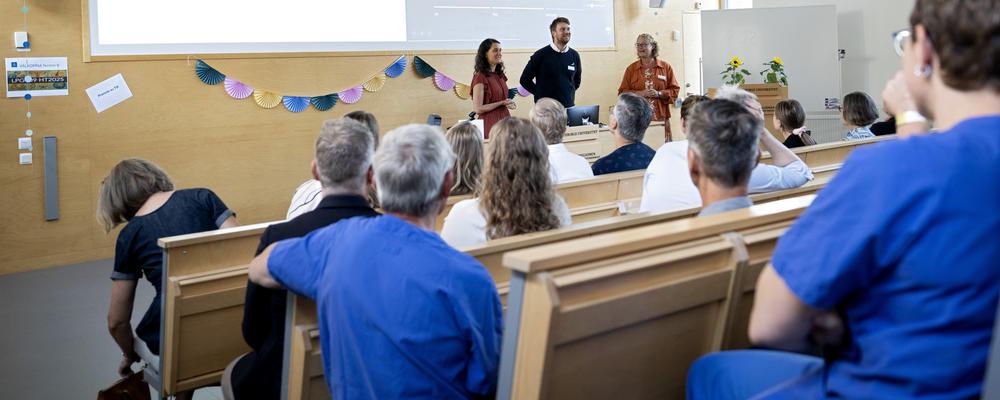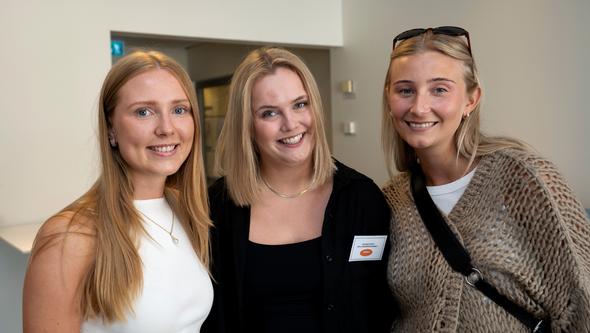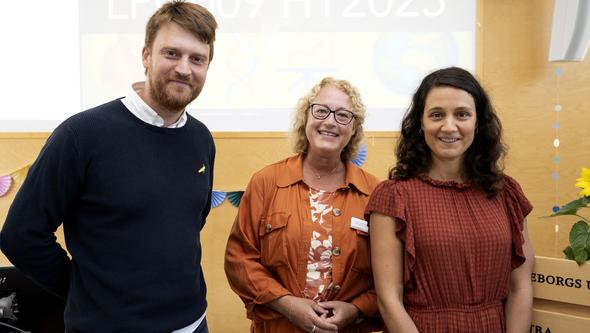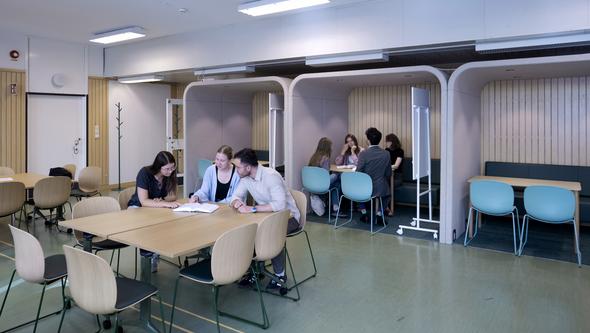
- Home
- Premier for the new semester 9 in the medical program
Premier for the new semester 9 in the medical program
Balloons, streamers, and a packed hall at Östra Hospital set the stage as nearly 100 medical students kicked off their first day of semester 9.
The course begins a week earlier than usual to make the schedule work, since semester 11 of the old medical program is still running in parallel.
Many students had been eagerly waiting for this moment – including Ellen Kåberg:
“We’ve all been waiting for this semester,” she said. “For me, the highlight will be meeting children and their families in pediatrics.”
“You can tell this course has been carefully planned. The introduction we received is the most thorough so far in the program,” said Sofia Kallin.
“What feels especially encouraging is how committed the course leadership seems to be,” added Natalia Poljak.

Many subjects
The new semester 9 course combines a wide range of clinical disciplines – from pediatrics, pediatric surgery, and pediatric orthopedics to gynecology and obstetrics, dermatology, clinical genetics, child and adolescent psychiatry, professional development, and global health.
The schedule is intense, but students will also have many opportunities to sharpen their skills. They’ll practice everything from communicating with child patients and performing gynecological exams to writing clear and concise referrals for skin conditions, breaking difficult news to patients and families, and understanding how background and living conditions shape health both globally and in Sweden.

Close collaboration
For the teaching team, the course is the result of years of preparation. Close cooperation across disciplines made it possible to run semester 9 of the new program alongside the final semester of the old one. One example is how dermatology teaching has been paired with clinical placements in obstetrics, with groups of students switching halfway through the semester.
“This was the only way to ensure good supervision while keeping the quality of clinical training,” said dermatologist Sam Polesie, semester 9 examiner, who oversees assessments across the course.
“Designing student-centered exams that reflect the learning goals has been a rewarding challenge,” he continued. “It also showed the value of sharing teaching experience across disciplines. That strengthens quality and supports a more student-focused approach.”
“Collaboration across subjects has been essential, and the high level of commitment is what makes this course possible,” said semester director Verena Sengpiel.

Support and respect
The course leadership emphasized that students should feel supported throughout their training. If something doesn’t work or feels problematic, it should be raised – both so it can be fixed right away and to help improve the course for future cohorts.
“Students should be treated as the future colleagues they are. If they don’t experience respect in clinical settings, it’s important we hear about it. We can only address what gets raised,” said Verena Sengpiel.
Professor of pediatrics and deputy course director Diana Swolin-Eide highlighted the importance of open communication:
“Our goal is to give students the best possible conditions for learning. We know it’s an intense course – for both the teaching team and the students. We want to do everything we can to ease the pressure. That’s why it’s important that students speak up if something isn’t working. We want to listen, adjust along the way, and make sure students are treated well during clinical placements.”
New student facilities
Ahead of the course start, the University of Gothenburg and Sahlgrenska University Hospital invested in modern, light-filled student facilities at Östra Hospital. These include group rooms, a small lecture hall adaptable to different teaching methods, and a kitchen for lunches and coffee breaks.

“The facilities are fantastic and will really make daily life easier for our students. It’s easier to stay at the hospital and work together in groups. That’s concrete support for their education – and good learning environments must be a priority,” said Diana Swolin-Eide.